Sunday 10th July 2022
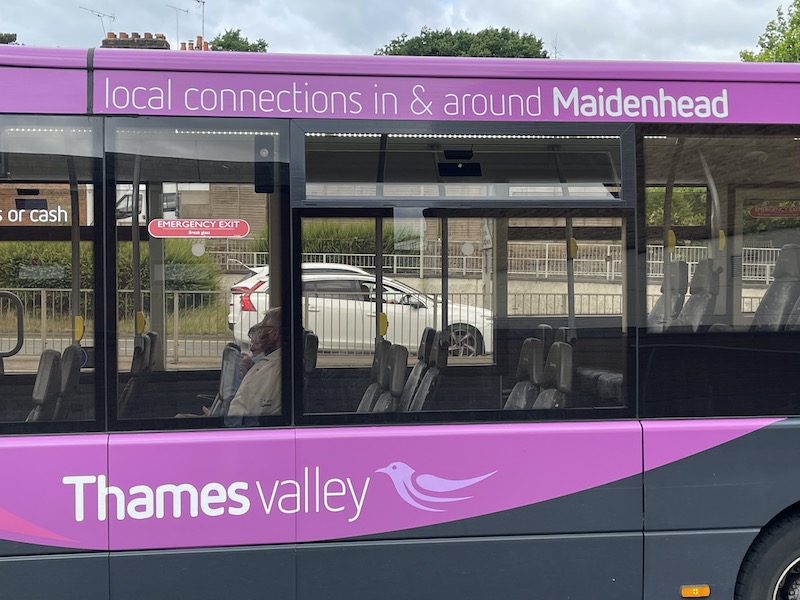
Ian kindly suggested Margate as a suitable M for my fortnightly A-to-Z wanders and I almost took him up on it but its proximity to neighbouring Ramsgate and the urban sprawl of Thanet made me question its suitability due to my criteria of choosing ‘independent’ mid size towns where possible and his other suggestions of Maidstone, Medway and Middlesbrough are also on the largish size, so I got up early last Saturday morning to head for Macclesfield in East Cheshire which seemed to tick the necessary boxes only to check my emails and read one from Zak suggesting M could be for Maidenhead. “It’s got the lowest bus patronage in the country and has a good mix of First, Arriva, Railair, Reading Buses” he wrote, which intrigued my enquiring mind as to why should this Berkshire town, famous for its proximity to the River Thames and its MP being Theresa May, have such low bus patronage? I set off to find out.
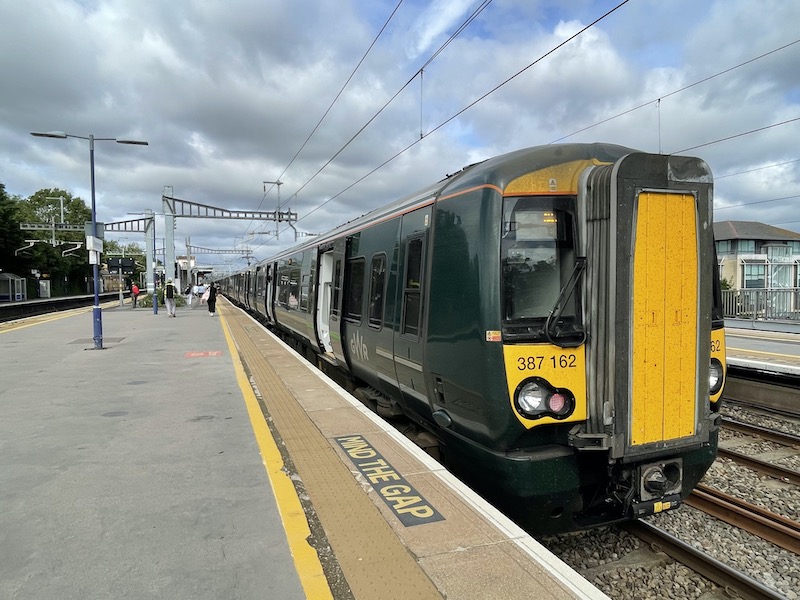
From Paddington I had a choice of a 39 minute journey on the newly branded half hourly Elizabeth Line or a 32 minute ride on GWR’s half hourly semi-fast train to Didcot Parkway. I chose the latter (and came back on the former). I wondered why the 08:57 departure from PAD was so packed with very posh looking over dressed passengers until realising Saturday was Henley Regatta weekend and they were all heading to Twyford, the next station beyond Maidenhead, for the branch line to Henley.

Arriving at Maidenhead on the station’s five platforms astride the two fast lines and two slow lines plus the branch line that heads off to Bourne End and Marlow I found the connecting hourly train waiting departure. A couple of passengers made the connection which involves using the subway to change from platform 3 to platform 5 but there’s a convenient six minutes allowed for that.

Maidenhead station gives the impression of being nicely looked after with a refreshment kiosk on platforms 4 (for London) and 5 (for Marlow) which was open all day on Saturday. It’s a GWR managed station so doesn’t have TfL’s roundels as many other (TfL managed) stations now do on this line. This care doesn’t seem to stretch to looking after the payphones on platforms 2/3 and 4/5 which are definitely passed their sell by date.


There’s a side southern pedestrian entrance/exit from the station on to Shoppenhangers Road with the main entrance/exit to the east on the main A308 Braywick Road which has had a makeover in recent years with improved ‘public realm’ and space for taxis and dropping off/picking up.

The bus stop immediately outside on Braywick Road has a shelter with timetable departures shown as a long list which is good but a bit overwhelming for a visitor just arriving in the town.

There’s also another bus stop just round the corner in Grenfell Road used by other routes from the town centre to the north of the town.

Maidenhead’s town network of bus routes is operated by Thames Valley the reinvigorated name now used by Reading Buses for the former Courtney operated routes the company bought out in March 2019. Since my visit to ‘B is for Bracknell‘ back in January, there was evidence the Thames Valley branding was now much more dominant with its coloured variations for some routes, although one or two seemed to be on the wrong route, perhaps partly because of inter-working between routes for scheduling efficiency.

There’s a very helpful map on the Thames Valley website which is always a boon to working out which route goes where. As you can see there are four main town routes – two to the north and two to the south – which doesn’t sound many for a town of around 70,000 population. All the more so when you realise three of them run hourly (pinkish 3; purple 8 and grey 9) and the fourth (green 7) running half hourly – although last Saturday it had reduced to hourly due to driver shortages. There’s also an hourly off-peak Monday to Saturday projection of routes 16/16A from the town centre to St Mark’s Hospital serving roads which otherwise wouldn’t have a bus.
That’s probably the first clue of why bus use per head of population is so low in the town; bus route frequencies are low too. But having spent the day travelling over each route it’s clear the frequencies match the demand and unless a company was brave enough to do a “Harry Blundred” on the town – a reference to the minibus pioneer in the late 1980s who flooded Exeter (and a few other towns) with high frequency converted vans into minibuses – at huge commercial risk, then nothing is going to change. Reading Buses know how to run high profile branded frequent bus routes where the demand is there – it’s home town is testament to that – but the market for bus travel in Maidenhead is just not there in the same way. Density of housing is far less in Maidenhead than Reading and although a lot of commercial development is currently taking place in Maidenhead’s town centre it’s small fry compared to Reading’s town centre which acts as a regional retail magnet, including for residents of Maidenhead as well as the location of considerable employment, a large ‘county’ hospital and a university.
Maidenhead was once administered within Berkshire County Council, but this was abolished in a 1998 reorganisation when it was replaced by unitary authorities including the Royal Borough of Windsor and Maidenhead, based at the Town Hall in Maidenhead.
You get an idea of the level of disinterest the Royal Borough takes in public transport within its environs by its webpage on ‘Transport and Streets’ and the subpage entitled Public Transport which offers advice on concessionary fares and ‘Bus Route information’ which in turn states “Below are some of the most popular bus routes within the borough. If your route is not listed please visit one of the bus company websites below.”

Listed are just six routes across the whole Borough, two of which are inter-urban routes serving Maidenhead – half hourly route 4 operated by First Bus between Maidenhead, Slough and Heathrow Airport ….
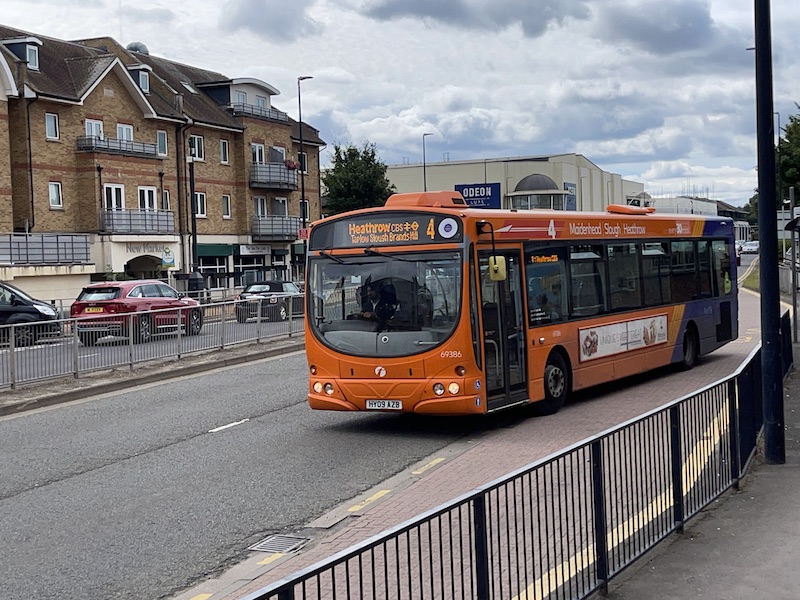
….. and hourly route 37 operated by Arriva between Maidenhead and High Wycombe.
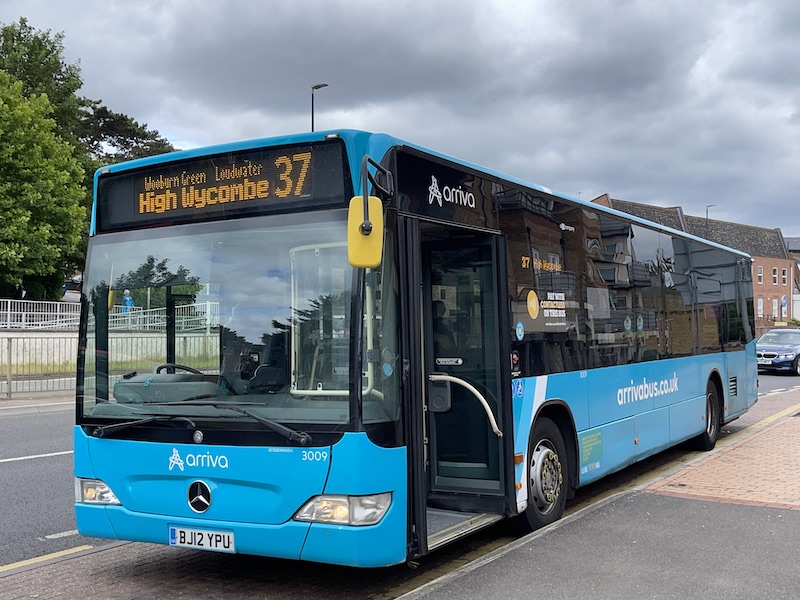
The only link to a website at the bottom of that page is to Reading Buses’ site – which doesn’t include the Thames Valley routes in Maidenhead – they’re listed on a separate website (not linked to). There’s also no links to Arriva or First Bus’s websites.
Interestingly there’s also no reference to the town routes operated by Thames Valley Buses on the Royal Borough’s website, which perhaps is another clue to the low patronage – a rather blasé attitude of the local authority.

Bus stops and timetable displays look to be the responsibility of the local authority and where they are displayed the latter are to the usual format of colour coded routes showing departures each hour, but on my travels I also noticed quite a number of bus stops with blank displays or vandalised cases.

Electronic displays are installed in the bus shelters in Frascati Way – effectively the main ‘bus station’ for the town – a dual carriageway west of the commercial centre ….

….. which didn’t look like “real” times, and there’s a rather dated looking and ineffective free standing display showing departures which are impossible to read, and really needs removing.


The bus shelter displays at these key bus stops aren’t exactly inspiring to attract passengers either.


After the Frascati Way bus terminus buses head off on a slightly circuitous routing taking a couple of minutes to reach a bus stop in the section of High Street just east of the pedestrianised section by Market Street.
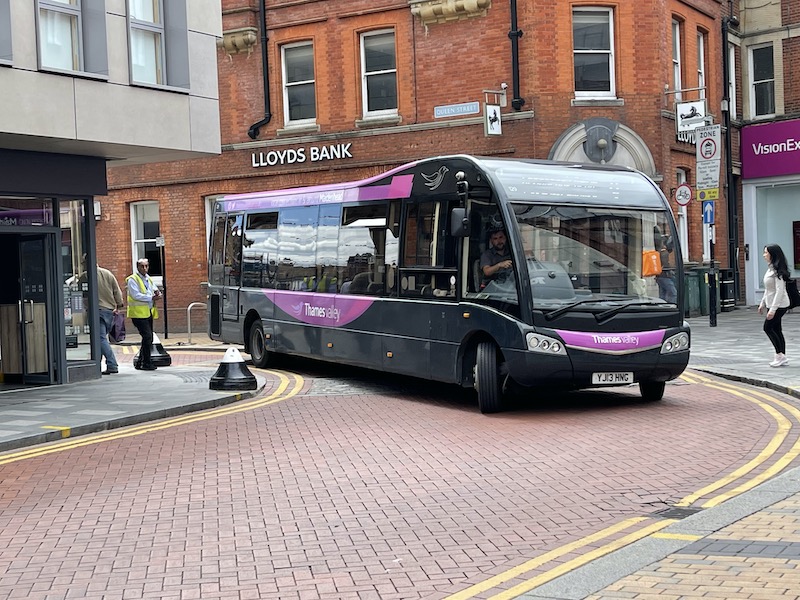

On my journeys on town routes 3, 7, 8 and 9 this is the stop where we picked up most passengers. On one journey someone got on at the next stop by the library, but otherwise that was it, indicating the bus network is very much a one trick town centre destination and one with few trip attractors located elsewhere. Another factor in explaining the low use.

It was noticeable most passengers were seen travelling on route 7 – the one which runs half hourly – although, as already mentioned, on Saturday every other journey was missing and passengers on board were having a grumble. “It’s all becoming unreliable again” was one comment which shows that despite details of which journeys are cancelled online, not everyone consults this.
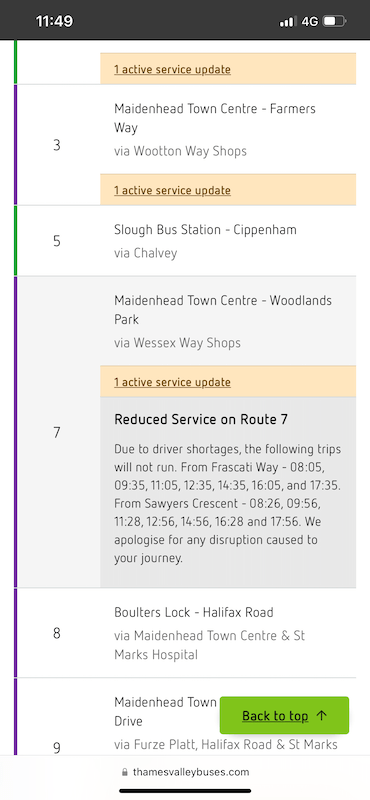
It doesn’t take long to get from the town centre to the outer terminus of these town routes. Route 3 for example only takes 24 minutes to do a round trip to Highfield Lane and back – eleven people travelled on the 11:23 from Frascati Way last Saturday.

Route 7 takes around 20 minutes to its Woodland Park terminus in the south east of the town and had around 15 passengers on board and a similar number back into town at about midday.
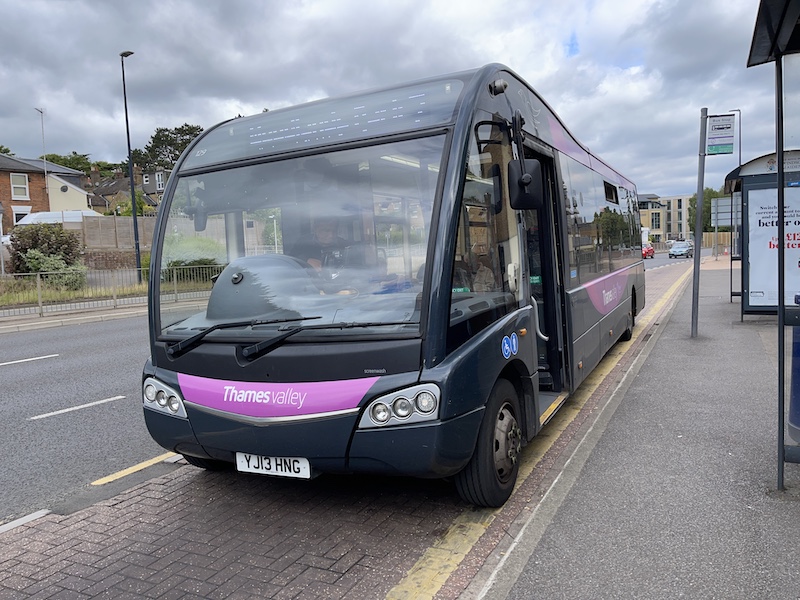
Route 8 operates in two halves to the north of the town with 10 travelling to the Halifax Road area (to the west) at 12:30 and four back again and only four travelled from the town centre over to Boulters Lock (to the east) and just one travelled back in. Boulters Lock was very busy with luxury looking craft passing along the River Thames.

I doubted many had used the bus to get to the moorings.
It takes about an hour to do a round circuit on route 8 whereas the fourth and final town route, the 9, operates an anti-clockwise circle to the north of the town taking just over half an hour – the 13:55 journey took seven passengers out and brought two back in.

The most quirky route I travelled on was rural circular route 234 which on Saturdays runs just two journeys aimed at shoppers with departures from Frascati Way at 10:15 and 12:45. It takes about an hour to do the full circuit via the delightful villages of White Waltham and Waltham St Lawrence.

The driver was a bit puzzled when I boarded the 10:15 journey but I explained I was just along for the ride – he seemed pleased for the company as he explained he didn’t think we’d see any other passengers, and he was almost right, as we completed most of the circuit without anyone boarding until we got back to the A4, where other routes also provide an option, and we picked up three passengers.
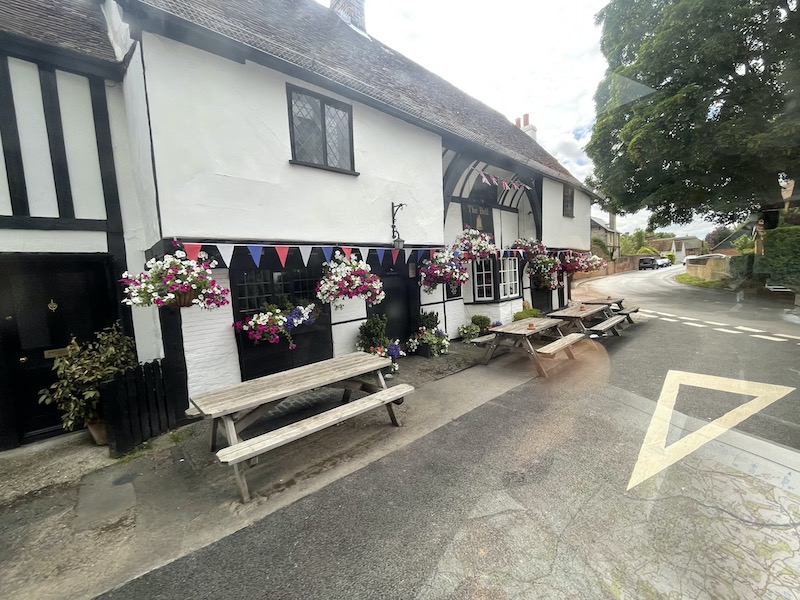
Mondays to Fridays sees a few other journeys added to the timetable, but I can’t see Saturday’s timetable continuing much longer based on this experience.
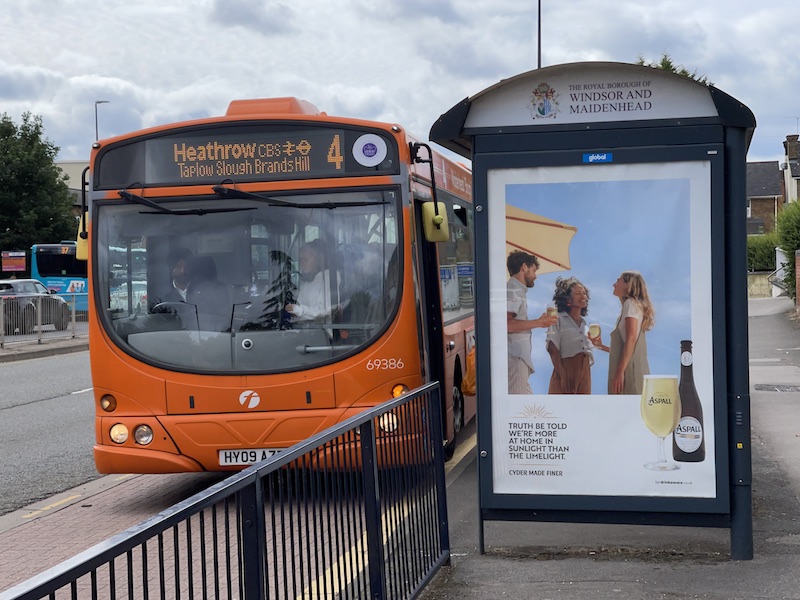
As already mentioned First Bus and Arriva operate inter-urban routes 4 to Slough and Heathrow (which departed with single figure loadings) and 37 to High Wycombe (with few passengers spotted on board as buses departed) respectively while Thames Valley run routes 16/16A to Windsor on an hourly frequency to nearby Bray and then via slightly different routes across the Borough as well as route 15 to Slough via Taplow, Eaton Wick and Eaton with just four journeys a day.
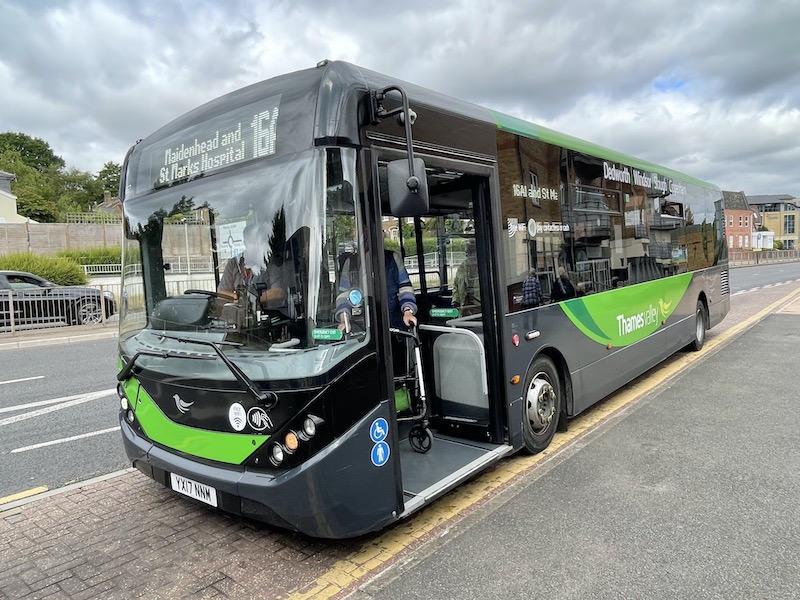
I took a ride on routes 15 and 16 back in November 2019 so didn’t include them in my itinerary this time, as I blogged about that trip at that time.
It’s been years since there was a regular inter-urban bus service between Reading and Maidenhead – a deficiency which has always puzzled me, although I appreciate there’s a good train service, but that applies to the link to Slough which manages to support the hourly route 4 already highlighted.
Thames Valley operate a four/five journeys a day Saturdays only route 127 between Maidenhead, Twyford and Reading that also operates via Sonning so takes about an hour whereas the train takes only 15 minutes. On Mondays to Fridays sister route 128 operates to Wokingham rather than Maidenhead.
And that’s about it for public transport in Maidenhead other than to mention RailAir which Zak referenced in his email. This previous non-stop service from Reading station to Heathrow Airport now diverts off the M4 to call at Bray Wick Cemetery which is about a mile south of Maidenhead rail station on the A308. The current timetable is to a rather unmemorable 35 minute frequency but for anyone living in the area, it does provide a quick 27 minute journey into Reading (or 45 minutes to Heathrow).
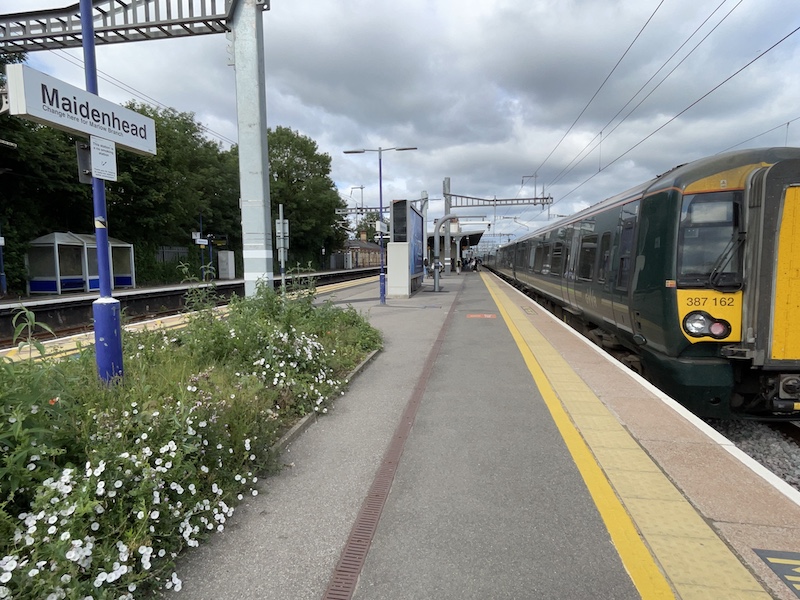
Roger French
Previous AtoZ blogs: Andover; Bracknell; Carlisle; Durham, Evesham, Folkestone, Grantham, Harrogate, Inverness, Jarrow, King’s Lynn, Leamington Spa.
Blogging timetable: 06:00 TThSSu


Real Time Bus Information
After a lot of detective work I believe there is a way to tell if Real Time information or Timetable information is being displayed
If the time is showing as Hours and minutes it is just display the time the bus is due according to the timetable
If the time is just shown as minutes the it is showing Live information. If the b us is due in less then 1 minute it changes to Due
The above is my understating of how it is supposed to work but given the many inconsistencies with these displays who knows. It is quite common they don’t show all the routes and quite common they display out of date timetable information
If the system has out of date timetable information then any real time information shown is likely to be wrong
Quite why though displays that are supposed to be showing Real time have buses mysteriously disappear . I have quite frequently had a display count down and show the bus as due but no bus appears and after several minutes it simply disappears from the display with no explanation
It could be some of the mysterious disappearing buses could b e due to the system having out of date timetable information
LikeLike
Real Time Information can have some strange effects sometimes. Many years ago when I was working in Croydon I would occasionally manage to skive off night shift a bit early and sometimes the Countdown display at the High Street bus stop where I waited for my bus home would be showing an N68 going to ‘Northbound’, which was odd because I knew that the last N68 had already gone some time ago. I watched as it got closer on Countdown until, when it was three or four minutes away, it disappeared off the display.
After this happened several times I checked the N68 timetable (what would we do without Robert Munster?) and sussed what was happening: Countdown was tracking the bus that had worked a southbound N68 returning light from Coulsdon, and it disappeared off the display when it got to South Croydon Garage.
LikeLike
That bus stop timetable display outside the station is bad. The service headers don’t fit into the space, and are cut off at the end, so you can’t see where most of the services are actually going. And I notice the Thames Valley one stuck up in another shelter still has Courtneys logo on. Still, no worries, everybody has a smartphone thse days, eh? /sarcasm
LikeLiked by 1 person
I’m waiting to find out what town you select for ‘Q’ !
LikeLiked by 1 person
Quorn?
LikeLiked by 1 person
Rulling out places because of urban sprawl would also rule out Middlesbrough as it effectively abuts Stockton, Thornaby and Redcar and then Stockton abuts Norton which abuts Billingham but a little bit of countryside between Billingham and Hartlepool although via the coast industry join the two up.The other way Redcar to Loftus is all joined up virtually.
LikeLike
Queensbury Yorkshire , Queensferry Scotland
LikeLike
With regards to the First number 4 route. It’s every 30 mins M-F and hourly at weekends however it’s increased to every 30 mins at weekends from today!
LikeLike
Many thanks – will update.
LikeLike
It seem strange that it appears you cannot get direct to Heathrow from Reading on the Elizabeth line
The were plans as a part of the GWR electrification to connecting the mainline up to Heathrow but nothing seems to have happened with that
Quote “As part of our Railway Upgrade Plan the Department for Transport asked us in 2012 to develop plans to build a new 6.5km rail link between the Great Western Main Line and London Heathrow Airport. The proposed rail connection would speed up journeys to Britain’s busiest international airport, by allowing passengers to travel to the airport from the South Coast, South West, South Wales and West Midlands without going into London Paddington.
The Western Rail Link to Heathrow (WRLTH) would leave the Main Line between Langley and Iver.
It would then descend underneath the main railway line into a cutting before entering a 5km tunnel. The tunnel would pass under Richings Park and Colnbrook and then merge with existing rail lines underground at Heathrow Terminal 5.”
LikeLiked by 1 person
The estimated cost of the Western Rail Link does not leave much change out of £1billion. And given current inflation, probably no change at all now.
LikeLike
I think BT (who, of course, want to be rid of their public payphone responsibility!), rather than the station operator, are responsible for payphones on railway station platforms.
LikeLiked by 1 person
Yes, and to judge by the frustrated comments from some of my employer’s station management, BT consistently ignore reports of faulty payphones at stations. They won’t come out to repair them and nor will they come to remove them.
LikeLiked by 1 person
Judging by observations recently, the 4 linking Maidenhead with Heathrow, as did the former 75, looks to have revitalised it somewhat. Quite a bit of carry over in Slough, although not necessarily from Maidenhead.
In fairness to the Council, they did produce all local service timetables until recent times, freely available in Library racks, which thankfully obviated the need to explain to well-meaning Librarians what a bus timetable was, or in some cases a bus!
I too have never understood the lack of a Maidenhead-Reading link other than Saturdays. This was once a trunk service, linked for a while I recall with Newbury (?). And this is not a recent reduction, as I also recall Reading Mainline, a solely RM operation, either tendering for the Saturday service or certainly considering to do so, some thirty years ago and my then realising a weekday link no longer existed..
But all a far cry from scenes on the Bath road in the 1950s when Maidenhead based buses, “always one in sight”, provided an intensive service to Slough, many working as “Relief” and thus timetables not indicating just how busy the service was.
LikeLike
Someone definitely needs to do a Harry Blundred in places like this. NBC centrally purchased the minibuses and allocated them to operating companies I believe. It should be possible for the big groups to do this taking advantage of bulk purchase prices on Sprinters. Blundred employed customer service trained ex retail staff, his logic was it was easier to train customer service skilled people to drive what were effectively big cars, than to train bus drivers in customer service skills. He had a mixture of full and part time shift options available to widen appeal to employees.
If Maidenhead town centre is too poor to be a destination, then focus the network on the railway station so people can get to better places like Reading.
LikeLike
The Blundred approach wouldn’t be possible nowadays for the simple reason that the bus industry is struggling to recruit and retain enough drivers for the level of service they operate now.
There’s no way they could repeat the Blundred era mass recruitment of trainees at lower pay rates than current drivers when the current employment offer clearly isn’t attractive enough.
LikeLiked by 1 person
I think places like Maidenhead too far gone for intensive minibuses, Stagecoach tried in Ashford with Mercedes Sprinters and that did not last long. All of the local services are tendered, only the 4 and 37 remain Commercial.
As to Reading to Maidenhead, the 1 was every 30 minutes and the B London service every hour. But there are very few villages on the A4 and from Twyford into Reading there are other local services. I am amazed that frequency even lasted into the late 70’s . The vastly improved train service will have taken all the interurban traffic. Likewise services to Marlow and Henley from Maidenhead are now only rail served
LikeLiked by 1 person
Henley actually has the 238 a few times a day down the A4130 to Maidenhead, it isn’t much but it survives because of the presence of BCA (Berkshire College of Agriculture) at Burchett’s Green.
As you say, between Twyford and Maidenhead, there’s virtually nothing from the eastern edge of Twyford to Woodlands Park on the western edge of Maidenhead. The villages like Knowl Hill and Hare Hatch have sky high property prices, more so than most of the area. This excluding anyone who can’t afford a car or taxis. There is still the 850 from Reading through Sonning, Charvil and Twyford to Ruscombe (East Twyford), before it turns off in the Henley and HW direction.
Maidenhead’s biggest problem is the endless sprawl makes it ineffective to provide any intensive bus service.
LikeLiked by 1 person
I lived in Maidenhead from the mid-90s to the early 2000s and even back then the Town would probably have used the “Lowest Bus-ridership in the UK” as a marketing slogan to appeal to the kind of people it thought should be living there.
It’s a Car town, everyone has a car – usually more than one – and that’s not just because of comfortable affluence, it’s because everyone instinctively seems to know that the cost of living there means accepting you have to drive to get anywhere (usually in another town) to get anywhere useful or worthwhile.
The Town Centre has a constant process of hollowing out which has made it fairly unattractive as any kind of destination – there’s a Cinema/Leisure complex of sorts but even that has every appearance of being run-down practically from its opening.
So there’s hardly ever been any reason why a surge in demand for buses would be conceivable. Any attempt to ramp up would be an invitation to lose a lot of money and the locals would probably never even notice.
When I did live there I and my family did have a car – you couldn’t shop for a family of five for a week without one to get you out to the retail parks where actual shops where – but I was considered an oddball for mostly walking anywhere I needed to and even being mad enough to walk a mile to and from the Station to get to my commute rather than joing the queue of traffic around the one-way to get dropped off/picked up.
When car ownership (fuel or electric) finally prices out all but upper-management the whole Town will simply curl-up and expire leaving a brick and concrete husk that will be remarked upon as an archaeological oddity by future generations of Reading Dwellers on their way into London on the train, who will wonder what kind of society managed to live out such complacent and short-sighted little lives.
LikeLiked by 1 person
Things to consider regarding current and future bus users:
Young people are not learning to drive in the numbers that previous generations did, they can’t afford the lessons, the cars, the insurance, and now the fuel.
Electric cars are unaffordable to most people.
Town centres are changing from retail to social and entertainment focus. There is also a night time economy I’m lead to believe.
Blundred targeted retail staff to drive his minibuses. The supermarkets all use Sprinter vans so their drivers are already partly trained to drive minibuses. Pay more than the supermarkets, offer flexible shift patterns.
Railway stations. A ready market for outgoing and incoming people. Link the station/town centre to residential, business parks, hospitals, colleges.
Brand the thing with the town’s name to generate local pride.
Engage with the local council and build enthusiasm for the better bus network that you envisage, don’t wait for them to show initiative.
If the town is choked with traffic then there IS a demand for travel. See where the motorists are all going, plan a network that goes there too.
LikeLiked by 1 person
Could R be for Rushden and Rushden Lakes in Northamptonshire? It’s a grid locking “shopping and leisure” area and town traditionally served by United Counties. The flagship X46 X47 are run by Scania Stagecoach Gold buses with money which must come from the development as they run late into the night. Other services are to Kettering and Bedford. The usual lack of information and the gradual downgrading of the ‘Gold’ service don’t help with the increased traffic problems. I would be happy to help!
LikeLike
Although I only know Maidenhead by reputation and not personal experience, I’m not surprised by the low level of bus usage. When you think of the typical kind of person who lives in a very affluent Home Counties commuter town, and then think of the typical bus passenger, there isn’t a lot of overlap. If people have to slum it on public transport then the train is as low as most of them will go. When you look at the level of service in small towns and rural areas across wealthy areas of the south, it’s a very common problem!
LikeLiked by 1 person
Was it not Mrs Thatcher who said that it was only the poor that used public transport…?
LikeLiked by 1 person
I remember around 1988, “Buses Extra” had an article written about the town’s Thames Valley garage in 1968, which pointed out then how sparse passengers were in the area, a measure of it being one of the richest locales in the UK. Ernie Wise & Terry Wogan were former local residents, illustrating how prosperous the area is and hence, not really keen on the bus!
Given that, it seems the modern Thames Valley is doing the best it can in the area!
LikeLiked by 1 person
Ernie Wise didn’t actually live in Maidenhead itself but in a village between it and Windsor which I think was Dorney.I know that because a friend of mine worked for either Thames Water or the National Rivers Authority, can’t remember which it was,in Reading and Ernie rang up to complain about workmen digging in the river bank.Sadly Ernie has joined Eric now and doesn’t live anywhere well not on this planet anymore.Uri Gellar use to live around there too , but has moved to Israel, and Elton John plus one of the Two Ronnies, the little one I think,who I always mixed up with Morecambe and Wise!
LikeLiked by 1 person
If there’s ever an area that shows just how hard it will be to tackle car culture then Maidenhead is it, other comments have already picked up all the main reasons. There’s certainly a demand for travel as all the main roads are a constant procession of cars. As an aside I briefly dated someone from the area who I think considered the idea that you could leave the house without jumping in a car as a quaint eccentricity.
If you’re ever back in the area then the rail branches to Marlow, Henley and Windsor are worth an explore. They’re now diesel islands and have much more of a feeling of country branch lines then anywhere else I can think of in the South East.
The line to Marlow always seems reasonably well loaded and mirrors the route of the 37 as far as Bourne End, which must leave even slimmer pickings for the bus. The railway is also enhanced from hourly to half hourly in the two peaks. This involves splitting the service in half at Bourne End. Signalling arrangements are interesting as it involves the train staff operating equipment at Bourne End, again somewhat unusual for the South East!
The line did continue on to High Wycombe and actually survived Beeching but was closed in the seventies. I’m surprised it hasn’t popped up in any of the recent reopening proposals. I suspect it would be reasonably well used if it had survived, given the level of traffic congestion locally, but could never justify the cost of reopening.
LikeLiked by 2 people
Interesting read. I live here and the council would be very proud of the ‘lowest bus use’ epithet – they really do everything they possibly can to promote cars (including deliberately programming new pedestrian crossings to be slower to change for pedestrians). There isn’t a single bus lane in the whole of Maidenhead. All very sad really.
I don’t have a car and use the 4 to go to work (when not wfh). At peak times it has decent loads – especially mornings when concessionary passes aren’t valid. The 37 is less useful than it should be given it’s only hourly and the last service from Wycombe is at 1725 M-Sa, with nothing at all on Sundays. Given it replaced the branch line railway (that really should be reopened) this is particularly poor.
LikeLiked by 1 person